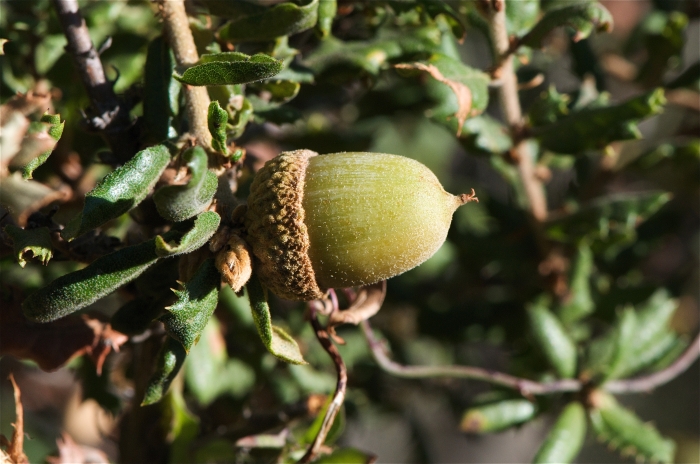Coastal Sage Scrub Oak
(Quercus dumosa)
Coastal Sage Scrub Oak (Quercus dumosa)
/
/

jkirkhart35
CC BY 2.0
Image By:
jkirkhart35
Recorded By:
Copyright:
CC BY 2.0
Copyright Notice:
Photo by: jkirkhart35 | License Type: CC BY 2.0 | License URL: https://creativecommons.org/licenses/by/2.0 | Uploader: Stickpen | Publisher: Wikimedia Commons | Title: Quercus_dumosa.jpg |




















































Estimated Native Range
Summary
Quercus dumosa, commonly known as coastal sage scrub oak or Nuttall’s scrub oak, is an evergreen shrub native to the coastal sage scrub and chaparral habitats of California. It typically grows 1 to 3 meters (3–10 feet) tall and is supported by a large, deep root network. The leaves are leathery with spiny or toothed edges, and the plant produces acorns up to 1.5 centimeters (5⁄8 inch) wide. Some individuals are prolific acorn producers, while others bear minimal fruit. Acorns are dispersed by gravity and animals such as squirrels and jays, which may eat them immediately or cache them for later. Germination of acorns is most successful in very moist years.
Quercus dumosa is valued for its drought tolerance and ability to thrive in the low-water conditions typical of its native habitat. It is suitable for xeriscaping and naturalistic landscapes in regions with a Mediterranean climate. In cultivation, it requires full sun exposure and well-draining soils, and it is adapted to low water availability. While it is not commonly used in urban planting due to its modest size, it can serve as an attractive addition to native plant gardens and restoration projects. Its deep roots can help stabilize soils on slopes. Potential problems include oak root fungus and susceptibility to sudden oak death, especially in areas with higher moisture. Gardeners should be aware of these issues and select planting sites accordingly.CC BY-SA 4.0
Quercus dumosa is valued for its drought tolerance and ability to thrive in the low-water conditions typical of its native habitat. It is suitable for xeriscaping and naturalistic landscapes in regions with a Mediterranean climate. In cultivation, it requires full sun exposure and well-draining soils, and it is adapted to low water availability. While it is not commonly used in urban planting due to its modest size, it can serve as an attractive addition to native plant gardens and restoration projects. Its deep roots can help stabilize soils on slopes. Potential problems include oak root fungus and susceptibility to sudden oak death, especially in areas with higher moisture. Gardeners should be aware of these issues and select planting sites accordingly.CC BY-SA 4.0
Plant Description
- Plant Type: Shrubs, Trees
- Height: 3-9 feet
- Width: 12-15 feet
- Growth Rate: Slow
- Flower Color: N/A
- Flowering Season: Spring
- Leaf Retention: Evergreen
Growth Requirements
- Sun: Full Sun
- Water: Low
- Drainage: Fast, Medium
Common Uses
Bee Garden, Bird Garden, Butterfly Garden, Fire Resistant, Hedges, Low Maintenance, Rabbit Resistant
Natural Habitat
Native to coastal sage scrub and chaparral habitats of California
Other Names
Common Names: Nuttall’s Scrub Oak
Scientific Names: Quercus dumosa , Quercus macdonaldii var. elegantula , Quercus dumosa f. diversifolia , Quercus dumosa f. linearis , Quercus dumosa f. microcarpa , Quercus dumosa f. crispata , Quercus dumosa f. insularis , Quercus dumosa var. linearis , Quercus dumosa f. longigemma , Quercus dumosa f. myrtifolia
GBIF Accepted Name: Quercus dumosa Nutt.